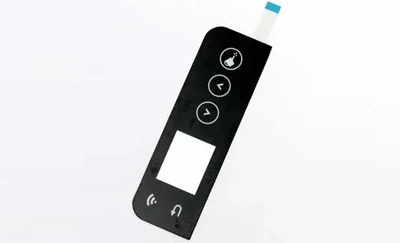
Clean the surface that needs to be fitted with the membrane switch (the surface should be flat, rust-free, oil-free, and dust-free);
Compare the dimensions (place the custom membrane switch in the fitting position and check if the dimensions are correct);
Peel off about 10mm of the release liner from the bottom of the membrane switch;
Then position the membrane switch in the corresponding position, gradually peel off the remaining release liner (within 15-degree angle limit), and stick it to the corresponding position;
If the membrane switch is not aligned with the release liner during the sticking process, it needs to be put aside first. It should be placed facing up to avoid sticking to other objects that may affect the sticking;
Precautions: Sticking should not be repeated, it should be completed in one go. The peeling angle should not exceed 15 degrees. When testing the touch, it must be placed flat on the table before pressing, and should not be pressed while held in the air, as both will affect the lifespan of the membrane switch.
Ink adhesion inspection: After attaching the ink with transparent tape, press it with hand to ensure no bubbles for 10 seconds, and then remove it quickly without any ink detachment. After the insulating ink is dry, attach the ink surfaces to each other and press with heavy pressure for 24 hours, ensuring that the insulating surfaces do not stick together. Attach with pressure-sensitive tape, press with hand to ensure no bubbles for 1 minute, and remove it without any ink falling off.
Peel strength test: The peeling strength of the adhesive should be no less than 8N/25mm.
Bubble test: Maintain a uniform height and balanced force. Planar type: 57-284g force, tactile type: 170-397g force.
Fold strength test: After the silver paste and carbon ink circuit have undergone drying treatment, measure the circuit resistance first, then fold the circuit by 180 degrees and apply finger pressure of 2kg/2 seconds, then let it recover to a flat state. Repeat this process 5 times and measure the resistance again. The increase in resistance after 5 folds should not exceed 300Ω of the original resistance.
Hardness test: Use an H-grade drawing pen nib to apply 1kg of force at a 45-degree angle to the circuit. There should be no conductive ink detachment or transparency.
Life test: The non-tactile buttons should have a touch conductivity of over 1 million times. The tactile buttons should have a touch conductivity of over 500,000 times.
Circuit resistance test: The resistance value should not exceed 100Ω. For circuits with a total length greater than 150cm and special requirements for circuit resistance, additional rules should be followed according to the drawing. There should be no disconnection or short circuit.
Insulation resistance test: In a normal temperature and humidity environment, the insulation resistance of the conductor circuits should be greater than 500MΩ (500VDC for 1 minute). After high temperature and constant humidity tests and salt spray tests, the insulation resistance should not be lower than 20MΩ.
High-temperature test: After being subjected to a high temperature of 55±2℃ for a duration of 72 hours, the appearance quality should comply with the drawing specifications. After 2 hours of recovery under normal atmospheric conditions, the insulation resistance should comply with the specifications.
Low-temperature test: After being subjected to a low temperature of -10±3℃ for a duration of 16 hours, and then recovering for 2 hours under normal atmospheric conditions after wiping off the water droplets on the surface, the resistance value should comply with the specifications.
Salt spray test: After being subjected to a 5% sodium chloride salt solution, in a test space with a temperature of 35±2℃ and a duration of 72 hours (with connector sealed), after 2 hours of recovery under normal atmospheric conditions, the insulation resistance should comply with the specifications.
Constant humidity and heat test: After being subjected to a stable humidity and heat test of 40±2℃ and a relative humidity of 93 (+2/-3) for 96 hours, and then recovering for 2 hours under normal atmospheric conditions, the insulation resistance, circuit resistance, and button touch force should comply with the specifications.
You may also be interested in following products offered by Niceone Tech:
If you have any questions, we will help you!
PREV